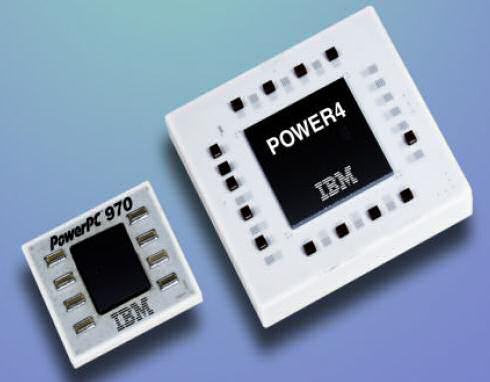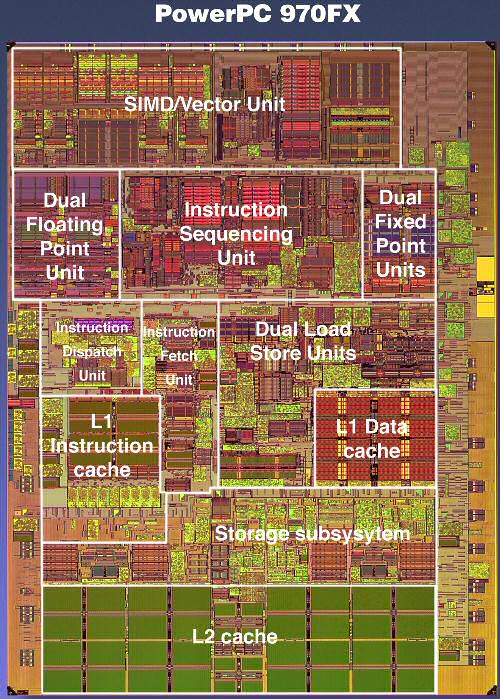No more mysteries: Apple's G5 versus x86, Mac OS X versus Linux
by Johan De Gelas on June 3, 2005 7:48 AM EST- Posted in
- Mac
IBM PowerPC 970FX: Superscalar monster
Meet the G5 processor, which is in fact IBM's PowerPC 970FX processor. The RISC ISA, which is quite complex and can hardly be called "Reduced" (The R of RISC), provides 32 architectural registers. Architectural registers are the registers that are visible to the programmer, mostly the compiler programmer. These are the registers that can be used to program the calculations in the binary (and assembler) code.
The 970FX is deeply pipelined, quite a bit deeper than the Athlon 64 or Opteron. While the Opteron has a 12 stage pipeline for integer calculations, the 970FX goes deeper and ends up with 16 stages. Floating point is handled through 21 stages, and the Opteron only needs 17. 21 stages might make you think that the 970FX is close to a Pentium 4 Northwood, but you should remember that the Pentium 4 also had 8 stages in front of the trace cache. The 20 stages were counted from the trace cache. So, the Pentium 4 has to do less work in those 20 stages than what the 970FX performs in those 16 or 21 stages. When it comes to branch prediction penalties, the 970FX penalty will be closer to the Pentium 4 (Northwood). But when it comes to frequency headroom, the 970FX should do - in theory - better than the Opteron, but does not come close to the "old" Pentium 4.

The 970FX works out of order and up to 200 instructions can be kept in flight, compared to 126 in the Pentium 4. The rate at which instructions are fetched will not limit the issue rate either. The PowerPC 970 FX fetches up to 8 instructions per cycle from the L1 and can decode at the same rate of 8 instructions per cycle. So, is the 970FX the ultimate out-of-order CPU?
While 200 instructions in flight are impressive, there is a catch. If there was no limitation except die size, CPUs would probably keep thousands of instructions in flight. However, the scheduler has to be able to pick out independent instructions (instructions that do not rely on the outcome of a previous one) out of those buffers. And searching and analysing the buffers takes time, and time is very limited at clock speeds of 2.5 GHz and more. Although it is true that the bigger the buffers, the better, the number of instructions that can be tracked and analysed per clock cycle is very limited. The buffer in front of the execution units is about 100 instructions big, still respectable compared to the Athlon 64's reorder buffer of 72 instructions, divided into 24 groups of 3 instructions.
The same grouping also happens on the 970FX or G5. But the grouping is a little coarser here, with 5 instructions in one group. This grouping makes reordering and tracking a little easier than when the scheduler would have to deal with 100 separate instructions.
The grouping is, at the same time, one of the biggest disadvantages. Yes, the Itanium also works with groups, but there the compilers should help the CPU with getting the slots filled. In the 970FX, the group must be assembled with pretty strict limitations, such as at one branch per group. Many other restrictions apply, but that is outside the scope of this article. Suffice it to say that it happens quite a lot that a few of the operations in the group consist of NOOP, no-operation, or useless "do nothing" instructions. Or that a group cannot be issued because some of the resources that one member of the group needs is not available ( registers, execution slots). You could say that the whole grouping thing makes the Superscalar monster less flexible.
Branch prediction is done by two different methods each with a gigantic 16K entry history table. A third "selector" keeps another 16K history to see which of the two methods has done the best job so far. Branch prediction seems to be a prime concern for the IBM designers.
Memory Subsystem
The caches are relatively small compared to the x86 competition. A 64 KB I-cache and 32 KB D-cache is relatively "normal", while the 512 KB L2-cache is a little small by today's standards. But, no complaints here. A real complaint can be lodged against the latency to the memory. Apple's own webpage talks about 135 ns access time to the RAM. Now, compare this to the 60 ns access time that the Opteron needs to access the RAM, and about 100-115 ns in the case of the Pentium 4 (with 875 chipset).A quick test with LM bench 2.04 confirms this:
| Host | OS | Mem read (MB/s) | Mem write (MB/s) | L2-cache latency (ns) | RAM Random Access (ns) |
| Xeon 3.06 GHz | Linux 2.4 | 1937 | 990 | 59.940 | 152.7 |
| G5 2.7 GHz | Darwin 8.1 | 2799 | 1575 | 49.190 | 303.4 |
| Xeon 3.6 GHz | Linux 2.6 | 3881 | 1669 | 78.380 | 153.4 |
| Opteron 850 | Linux 2.6 | 1920 | 1468 | 50.530 | 133.2 |
Memory latency is definitely a problem on the G5.
On the flipside of the coin is the excellent FSB bandwidth. The G5/Power PC 970FX 2.7 GHz has a 1.35 GHz FSB (Full Duplex), capable of sending 10.8 GB/s in each direction. Of course, the (half duplex) dual channel DDR400 bus can only use 6.4 GB/s at most. Still, all this bandwidth can be put to good use with up to 8 data prefetch streams.










116 Comments
View All Comments
michael2k - Friday, June 3, 2005 - link
Well, it shouts to stay away from the XServe unless you happen to have vectorizable code that you have the resources to properly vectorize!erwos - Friday, June 3, 2005 - link
Excellent comparison of the platforms, although I actually wish they would have spent more time analyzing the graphs.Like the others, I would have liked to see a G5 / Linux benchmark (now that FC4 has a PPC version, you could run a fairly reasonable one), but I do admit it's not a very popular option compared to x86. My curiosity is whether MacOS X is the problem, or whether it's some sort of issue with the CPU itself. Seems unlikely the G5 would have such a fundamental flaw, but it does shout to stay the hell away from the Xserve until these issues are resolved.
-Erwos
Thresher - Friday, June 3, 2005 - link
As the owner of intel, AMD, and Mac based computers, I have to say this is one of the best and most thorough comparisons I've seen.You did an excellent job of isolating CPU and OS performance.
That being said, if performance were the only indicator, there is no doubt in my mind that AMD would be ruling the roost. However, personal preferences come into play to a great deal. Businesses like the reputation behind intel. I prefer the usability of Mac OS X. People have strong feelings about Microsoft that may color their decisions.
When it comes down to it, performance is important, but not the only reason people buy what they buy. I would say more often than not, the decision is made with only a modicum of logic.
Cruise51 - Friday, June 3, 2005 - link
I'd be interested in seeing how it performs on yellowdog aswell.IntelUser2000 - Friday, June 3, 2005 - link
People, in case some of you misunderstand, the 10.8GB/sec Full Duplex bus means that its two 32-bit 1350MHz bus, rather than one 64-bit bus in the PCs. Its not, 10.8GB/sec x 2 =21.6GB/sec bus, its 10.8GB/sec bus(or more correctly stated 5.4GB/sec x 2). Plus, it says in Apple site that it has TWO(yes two!!!) of the 10.8GB/sec buses, per CPU.Summary: Per CPU=10.8GB/sec
Per Dual Processor System=21.6GB/sec
Johan, about the AMD TDP number, they never state that its max power, they say its maximum power achievable under most circumstances, its not absolute max power.
JohanAnandtech - Friday, June 3, 2005 - link
Porkster: It is a little geekisch Unix joke. Where is your geekish you man spirit?Wessonality: Our next project if we can keep the G5 long enough in the labs.
Ailleur2: indeed, I agree. The G5 is a potent CPU with a lot of potential. Just give it a bigger L2 and a better memory subsystem. This is an architecture that could last very long by applying a few tweaks, like the P6.
Methodical: All of the benchmarks are trustworthy, they should be looked upon as a whole to get a good picture, not just pick one. About After affects, I indicate that the G5 does very well here (seen other reports on the web), I just didn't have the software in the lab.
I also warned that this was not about "should I buy an Apple or not?". It is just "if performance is what counts for me, where should I position the G5/Mac os X combiantion compared to x86/Linux/Windows ?".
StuckMojo - Friday, June 3, 2005 - link
hmph. you say it yourself in the last paragraph...how come you didn't try it?
StuckMojo - Friday, June 3, 2005 - link
yes, it seems you've left out a very good method of testing if OSX is the issue: run a powerPC linux distro with the mysql and apache benchmarks and see what happens!i'd be _really_ interested in the results. see if you can update the article with them.
porkster - Friday, June 3, 2005 - link
"Root Me" in Australian slang is the same as "Fxxk Me" in common language. Some people my find a picture in this review offensive.wessonality - Friday, June 3, 2005 - link
What about installing Yellow Dog Linux on the XServe?